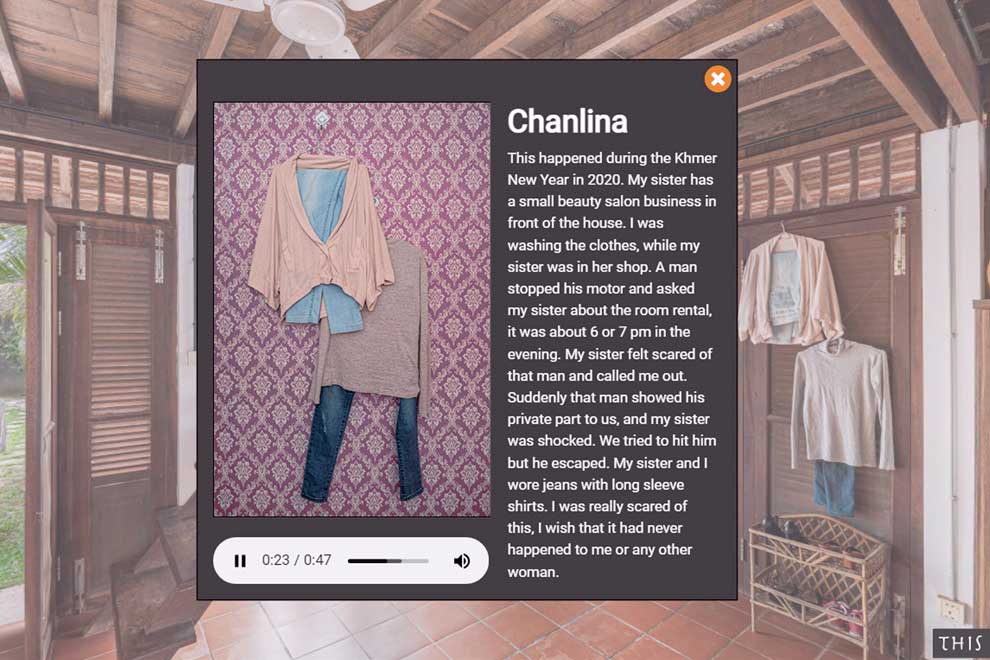
A screenshot from the short film Not Her Fault serves to raise awareness of domestic violence as part of the UN’s 16 Days of Activism to End Gender-Based Violence campaign. supplied
It is not about the boxing scene where Mixed Martial Arts fighter Chan Rothana confronted a frightened lady in the ring as in a previously viral media campaign to tackle domestic violence.
This year, This Life Cambodia (TLC) produced a short film entitled Not Her Fault to raise awareness of domestic violence as part of the UN’s 16 Days of Activism to End Gender-Based Violence campaign.
In its two-minute video, a young woman opens a wardrobe, takes out a white ultra-thin T-shirt and recalls a proverb her mother told her as a child – “without the hook, the fruit does not fall”.
The proverb reminded her of what happened once when she rode her motorbike home from the gym.
“Was it my fault? How? My clothes? Without the hook, the fruit does not fall,” she says in the short film.
“I could finally see that the things that had happened were not my fault,” she continues as she pulls off the tags on each item of clothing in her wardrobe.
TLC senior communication officer Hemmunind Hou tells The Post: “We used the proverb because many women told us they had heard it being used to blame women who were victims of harassment, violence, and abuse.”
The proverb implies woman must have done something to cause men to act in an aggressive manner. It wrongly implies that it is the woman’s fault, and the victim is then subjected to blame.
“Since the proverb is used with negative connotations, we felt it was important to confront it and the underlying implication that women are at fault should anything bad befall them,” she says.
Hou said that “women are often asked what they were wearing at the time they became victims of assault, suggesting that by wearing certain clothes they somehow attracted the attack on themselves, or in other words, they were ‘asking for it’”.

In a virtual exhibition, clothing hanging in a wardrobe tells the story of a harassment victim. Photo supplied
To change this perception, TLC felt they needed to confront the culture of victim-blaming head-on and tackle the social stigma associated with gender-based violence and harassment.
“Cultural beliefs are not always negative, and indeed many aspects are positive. Our campaign and exhibition challenge cultural beliefs that are used to blame women for crimes committed against them,” said Hou.
Not Her Fault has garnered over one million views on Facebook and was produced to provoke discussion about the issue on social media.
As part of the #NotHerFault campaign, women in Cambodia were invited to submit stories through various online platforms describing the times they experienced harassment, violence, or abuse.
In addition to its own Facebook page, TLC partnered with the Institute of Foreign Languages at the Royal University of Phnom Penh and the Royal University of Law and Economics Facebook Confessions Page which enabled them to gather stories confidentially.
Along with their stories, women were asked to include a photograph or description of the clothes they were wearing at the time.
Hou says that many women, including herself, have experienced some form of harassment or abuse.
“Instead of sharing our stories, we bottle them up for fear of being judged, and worse, we are made to believe that our experiences were not as serious as what others have gone through.
“I think it’s important for us to talk openly about this issue to show that we’re not alone and highlight how flawed society is in the hope of changing it,” she says.
TLC executive director Billy Gorter says it hopes that the interactive technology used in the exhibition will help it reach a wider audience.
“We believe it will allow us to further disseminate the message that what a woman wears when she is the victim of violence, harassment, or abuse is irrelevant,” he says.
The Siem Reap-based TLC collected the stories and selected 24 that represented various situations. The selected stories were used to create an interactive, online exhibition that is set at different times of the day inside a Cambodian house.
TLS says visitors to the exhibition website – https://thislife.ngo/notherfault/ – can explore the house and find the women’s clothing in different locations.
They can interact with the clothing and read or listen to the associated story in Khmer or English.
Exhibition curator Kasia Sumislawska says this exhibition is the first of its kind in Cambodia.
Julien Thomas, a travel-photographer with years of experience in Southeast Asia and the photographer who captured the 360-degree angle of the virtual exhibition says: “It’s great to have had the opportunity to contribute to such a worthy cause!”

In another section of the virtual exhibition, clothing hanging on a wall tells the story of a victim of harrassment.Viewers can interact with the clothes and read or listen to the associated story in Khmer or English. Photo supplied
TLC wants viewers to spend time looking around the house and discovering the stories it has to tell. It is important that they are able to do this at a pace that they are comfortable with.
Hou says: “Some viewers might find all of the stories, others only a few, and some might leave without reading or listening to any of them.
“People will have different levels of comfort and interest in the subject matter and it is wonderful that they can return as many times as they like,” she says.
TLC has a dedicated team that works each day to address gender-based violence in Siem Reap communities.
Its programme, This Life Without Violence, works to reduce the incidences of violence against women and children in Cambodia and its destructive impact on the entire community.
Gorter says he has a lot of respect for this team. “They do not expect praise for the work they do day in and day out. They just get on with the work that must be done to protect women and children from violence.”
For the last 12 years, TLC has asked Cambodian communities about the most serious challenges they faced. Domestic violence has always been among the top three issues that they are most concerned about.
“This is no surprise. One in three Cambodian men admits to having used violence against a partner in the past, indicating the scale of the problem.
“Of those women who experience violence, just 24 per cent seek any help, perhaps because a shockingly low eight per cent of Cambodians are even aware that domestic violence is a crime,” says a TLC report.
This Life Without Violence programme coordinator Hong Sarith says violence blights whole families and prevents communities from progressing as far as they can.
“So we work with community leaders and local authorities, including the police, so that they are ready to assist those families who are having to deal with the aftermath of violence.
“We also provide case management services and run support groups for them so they know they are not alone,” he says.














